In Vermont, it is possible to spot 8 different species of Hawks. These are:
- Red-Tailed Hawk
- Northern Harrier
- Broad-winged Hawk
- Red-Shouldered Hawk
- Swainson’s Hawk
- Sharp-shinned Hawk
- Cooper’s Hawk
- Rough-legged Hawk
Want to learn more? This book on the Birds of Prey of North America is a fantastic read!
The US state of Vermont sits nestled in the northeast Canadian border, southeast of the Canadian metropolis called Quebec, and directly east of White Mountain National Forest in neighboring New Hampshire.
This particularly includes birds-of-prey like Hawks, who are called to the cold northern winds.
The following is a list of the hawks found in Vermont, and how you can watch them.
Want to attract birds of prey to your yard? Take a look at our article!
What Hawks can be seen in Vermont?
1. Red-Tailed Hawk
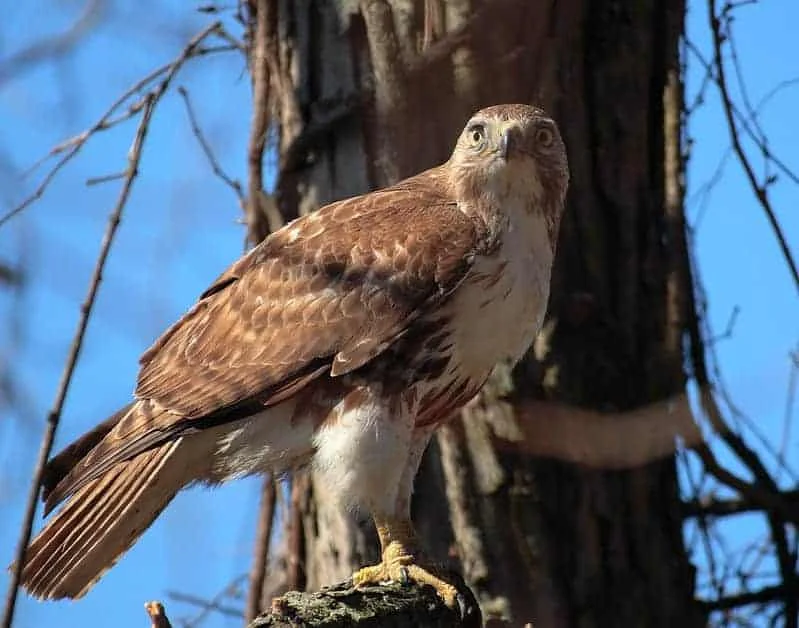
Vermont has a year-round breeding presence that covers most of the northern half of the state, with a residual non-breeding presence elsewhere.
Red-tails are the quintessential roadside hunter, and perhaps the least human-shy of all raptors in America.
They can be spotted in the dense forests near the northern border all year, but the residual migrations during extreme cold keep their presence consistent throughout the state.
Of course, this hawk is recognizable by the red feathers of its tail, which are closer to orange but appear red in contrast to the dark brown feathers around it.
The rest of a red-tail is usually brown speckled with white, or less commonly the other way around, with a face and crown of the same speckled pattern and a white underbelly.
These raptors hunt everywhere there is food, but they are ideally suited to open plains near the forest’s edge like most hawks.
They will frequently post up on man-made structures like signposts and telephone poles in civilization, ignoring people nearby unless they interrupt the hunt.
Beyond their relatively large size compared to other hawks, red-tails are also recognizable by their shrill cries, which are used time and again to express aviary prowess in film.
2. Northern Harrier
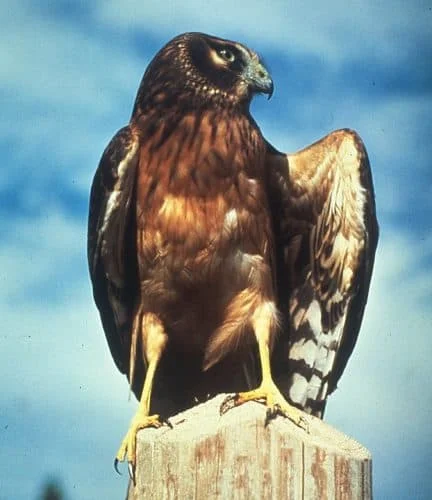
The ‘owl’ of the hawk family has an interesting migratory pattern in Vermont.
It breeds in great numbers in the northern tip of the state but seems to avoid the central and southern parts in any capacity except the occasional forays to the lowlands in extreme winter.
In fact, the northern harrier avoids the southern parts of New Hampshire and Maine as well but has no problem with Massachusetts, which borders each of these states to the south.
It is also the only harrier in North America, making the breeding grounds in northern Vermont invaluable. Beyond their owl-like faces with hardened feathers in circular disks, the harrier’s bulky body is usually a shade of grey interspersed with white.
It is not uncommon to see these grays spill into various shades of brown. Their underbellies are usually white with specks of their dominant color throughout.
Harriers are so-named because they glide over hunting grounds for hours at a time rather than striking from an elevated perch like most birds of prey.
These striking grounds are usually wetlands near pine forests, but harriers are more likely to hunt in areas where trees are miles apart than the next raptor.
3. Red Shouldered
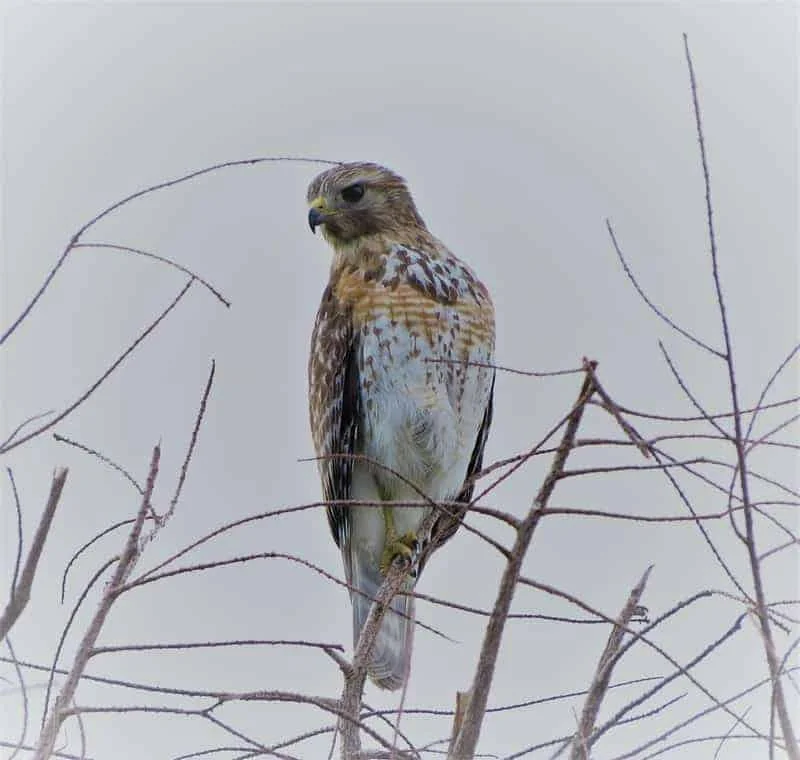
In another of our straightforward and useful naming conventions, the red-shouldered hawk is instantly recognizable by the red feathers adorning its shoulders like a cape, which spills over to cover the front of its neck and most of its chest.
Elsewhere, the colors on this bird vary widely, but always include a black-and-white striped tail and same-colored wingtips.
Their bodies are usually a speckled mix of deep browns or grays interspersed with white, which is inverted on their bellies and the bottom half of their faces.
You can find red-shouldered hawks deep in mixed forests near open wetlands and swamps seeking rodents and insects to take back to their high-perched nests.
4. Broad-winged Hawk
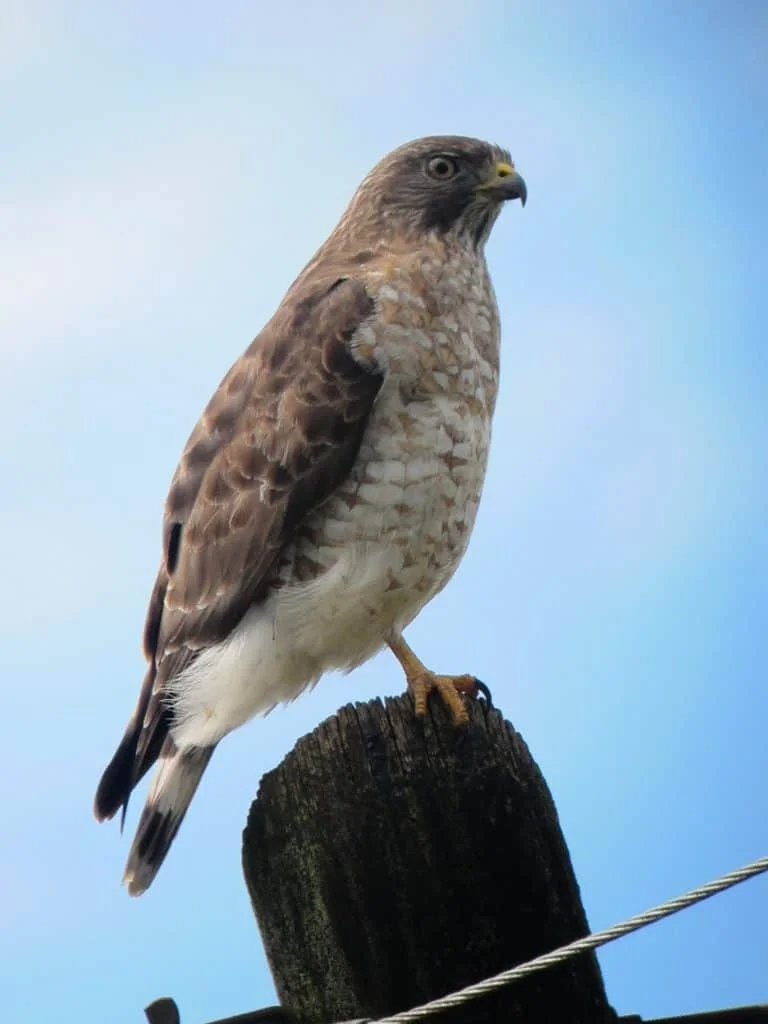
This aptly-named raptor is a year-round breed in most of the eastern US, including all of Vermont, especially since they’ve become a protected species in the region.
The broad-winged hawk is a nomadic traveler, often traveling to South America for the winter in large flocks called ‘kettles’. However, enough of its population overwinters in Vermont that their absence is hardly noticeable.
They can be spotted in flight by the sheer enormity of their wingspan compared to its relatively diminutive frame.
Else, they nest in tall mixed forest edges where perches are abundant, and those that give way to wide plains.
A typical specimen is an even shade of gray or brown, with a white underbelly and prominent stripes near the neck which reflects the colors on its back.
All specimens have a black and white striped tail, which stands out in-flight almost as much as the broadness of its wings.
5. Sharp-shinned Hawk
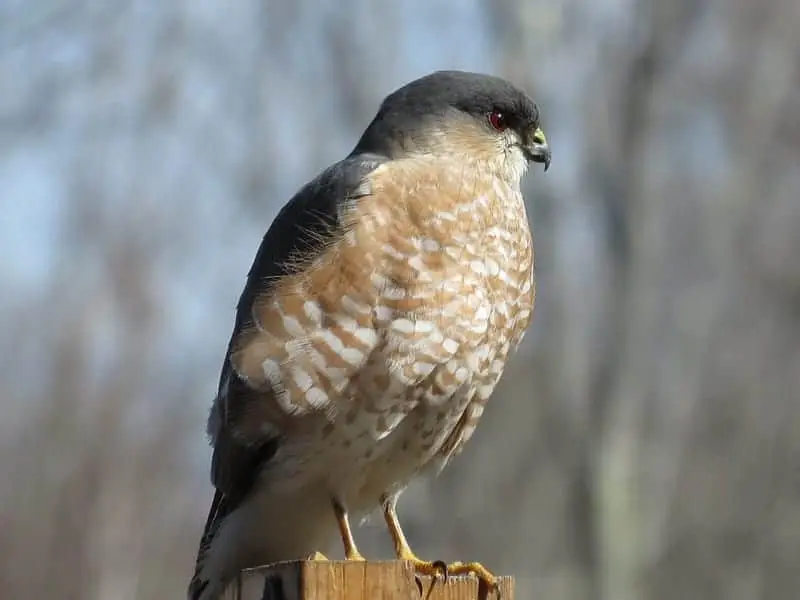
“Sharpies” as they are often called, are smaller versions of the cooper’s hawk, bearing a similar blue-gray coat atop a white and light brown underside.
These hawks are often mistaken for one other, though the Cooper’s is about six inches larger than a sharpie and heavier.
Sharp-shinned hawks also have rounder heads and are less sociable than cooper’s in terms of human contact.
These are woodland hunters, who hang in deciduous forests and hunt from stealth among the brush in riparian zones and riverside plains.
Sharpies are another of the hawks on this list who like to breed in Canada, but make no distinction between its climate and nearby Vermont.
6. Cooper’s Hawk
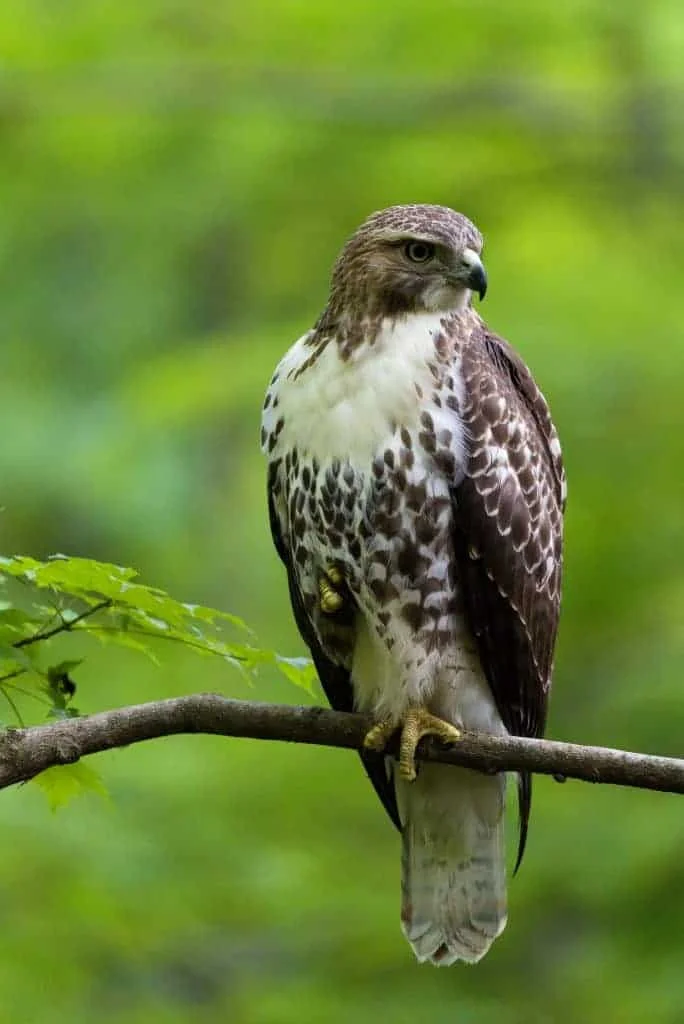
These raptors are as much a promising target for birdwatchers as they are a pest for people who don’t care for their incursions into their backyards.
The latter scenario occurs because backyard feeders attract their favorite foods, and coopers aren’t afraid to snatch them from civilization and fly back to their hidden nests.
Though not as intrepid as the red-tailed hawk, they breed throughout Vermont during the spring and summer, flying farther south in the winter. Like the sharp-shinned hawk, a cooper’s coat is usually blue-gray on the outside (wings, back, neck, and head), with a mix of white and light brown on the belly.
Less common morph may be all brown or gray speckled with white or an even darker brown that appears black from a distance.
Outside the bird feeders, they mostly thrive in dense woodlands with tall pines near water, with sufficient space for dive-bombing prey.
7. Northern Goshawk
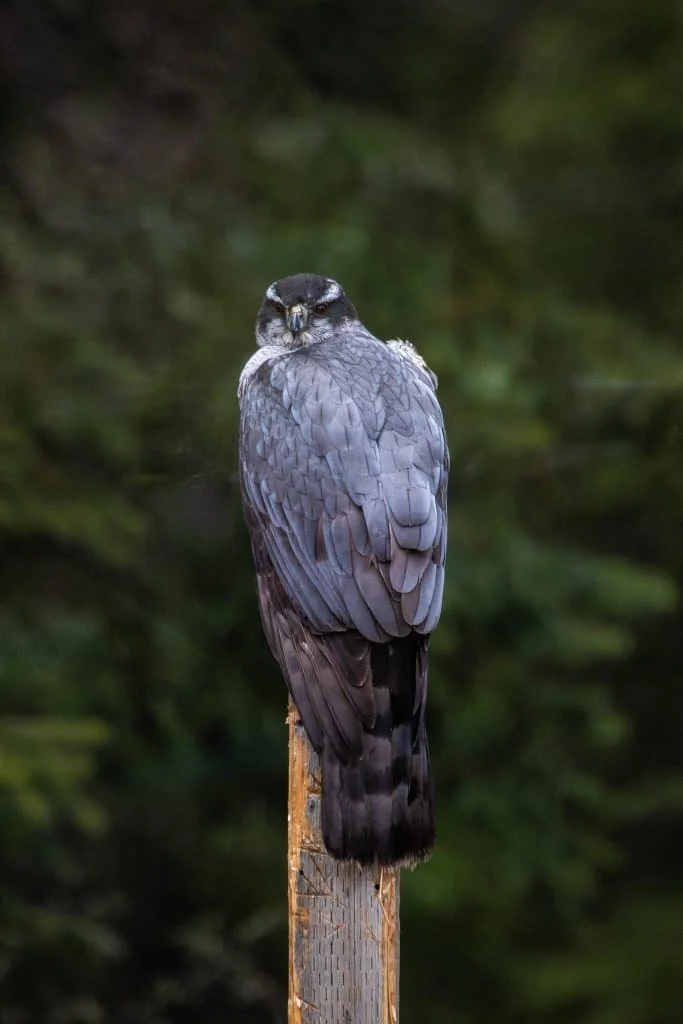
These aerial acrobats frequent the forests in the northwest of Vermont, though they can be seen all year round in various wooded areas throughout the state.
There is a distinct contrast with the goshawk’s plumage, as they wear black masks about the eyes, and its morphs have a white belly and dark everything else, usually a shade of dark grey or black, that looks like a tuxedo from afar.
Combine the look with its undeniable mid-air hunting prowess and you have the makings of a crowd-pleaser.
Look for northern goshawks in mixed forests that are far from civilization by following the rapid movement of wings between the trees. Be warned: the goshawk’s tendency to avoid open spaces and hunt among the branches makes it more challenging to spot.
8. Rough-legged Hawk
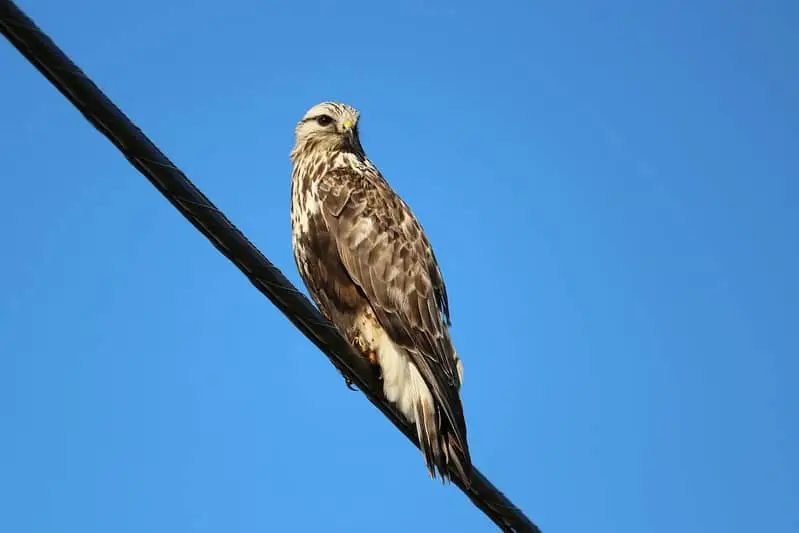
This arctic raptor is so-named because of the ‘rough’ feathers that extend from its body to cover its legs, likely an evolutionary adaptation to protect it from the cold of Canada’s far north.
Interestingly, the rough-legged hawk will fly from the extreme winters of the north to settle in the states rather than the southern part of Canada, which grants it a consistent winter presence in northern states like Vermont.
It can be hard to spot leg feathers from a distance even with binoculars, so look for their striped patterns which are more common to songbirds, and sharp contrasts between the colors of their outside feathers.
These can be black/gray and white, or dark brown and white, but they always have speckled patterns which become more pronounced at the wingtips.
The underside of this raptor’s wings might be a stark white compared to the mix of the rest of its body, making them easier to spot in flight and follow to a nesting area for cameos.
References
- https://www.audubon.org/field-guide/bird/northern-harrier
- https://www.audubon.org/field-guide/bird/swainsons-hawk
- https://www.audubon.org/field-guide/bird/ferruginous-hawk
- https://www.audubon.org/field-guide/bird/northern-goshawk
- https://www.audubon.org/field-guide/bird/sharp-shinned-hawk
- https://www.audubon.org/field-guide/bird/red-tailed-hawk

About Us
We are avid bird-watchers who recently retired, allowing us more time to travel the world. Fortunately, we have managed to visit numerous countries around Europe, Asia, and America. Watching and photographing birds has been a passion for many years and we are making the most of the extra time on our hands!
